The 2013 MacBook Air Review (13-inch)
by Anand Lal Shimpi on June 24, 2013 12:01 AM ESTThe GPU: Intel HD 5000 (Haswell GT3)
Hire enough ex-ATIers and you’ll end up really caring about GPU performance apparently. It’s good to see that Apple still views increasing GPU performance as non-negotiable, even at the MacBook Air level. Discrete GPUs are out of the question in the MacBook Air, so all models ship with Intel’s on-die processor graphics. More importantly, all CPU choices integrate the largest GPU offering: Intel’s HD 5000 (aka GT3).
Clock speeds alone prevent the 40 EU GPU implementation from being called an Iris 5100. Given the 15W TDP limit, Intel wouldn’t be able to do the Iris name justice even if it tried.
It’s hilarious that Intel refused to give out die photos for anything other than quad-core Haswell GT2, citing competitive concerns, yet at Apple’s WWDC launch of the new MacBook Airs we got to see the first die shot of a dual-core Haswell GT3. Update: I stand corrected. Intel posted its own shot here.
From the die photo it’s very obvious that like the quad-core Haswells with Iris Pro, the dual-core GT3 parts are over half GPU. Here's the only Haswell die shot Intel PR officially released by comparison, a quad-core GT2 part that's mostly made up of CPU cores:
Similar to the CPU discussion, on the GPU front Haswell has to operate under more serious thermal limits than with Ivy Bridge. Previously the GPU could take the lion’s share of a 17W TDP with 16 EUs, now it has 15W to share with the PCH as well as the CPU and 2.5x the number of EUs to boot. As both chips are built on the same 22nm (P1270) process, power either has to go up or clocks have to come down. Intel rationally chose the latter. What you get from all of this is a much larger GPU, that can deliver similar performance at much lower frequencies. Lower frequencies require lower voltage, which in turn has a dramatic impact on power consumption.
Take the power savings you get from all of this machine width, frequency and voltage tuning and you can actually end up with a GPU that uses less power than before, while still delivering incrementally higher performance. It’s a pretty neat idea. Lower cost GPUs tend to be smaller, but here Intel is trading off die area for power - building a larger GPU so it can be lower power, instead of just being higher performance.
| A Historical Look at MacBook Air GPU Performance | |||||||||
| 2011 | 2012 | 2013 | |||||||
| GPU | Intel HD 3000 | Intel HD 4000 | Intel HD 5000 | ||||||
| Manufacturing Process | 32nm | 22nm | 22nm | ||||||
| Frequency | 350/1150MHz | 350/1050MHz | 200/1000MHz | ||||||
| Cores | 12 | 16 | 40 | ||||||
| Peak GFLOPS | 165.6 GFLOPS | 268.8 GFLOPS | 640 GFLOPS | ||||||
| TDP | 17W | 17W | 15W | ||||||
This is an even bigger deal because few of the other OEMs seem interested in paying for the larger die. Acer’s S7 uses Intel’s HD 4400 (Haswell GT2, 20 EUs), as do most of the other Haswell Ultrabooks that have been announced thus far. Armed with a 2011, 2012 and 2013 MacBook Air as well as Acer’s 2nd generation S7, we now have the ability to compare everything from Intel’s HD 3000 (Sandy Bridge) all the way up to HD 5000. It’s important to keep in mind that with the exception of HD 3000, everything here is built on the same 22nm process, and with HD 4400/5000 TDPs actually went down. In other words, post Ivy Bridge, any GPU performance gains were very hard to come by.
I’m splitting up the GPU performance data into three sections. The first is a look at some games/settings that are actually playable on processor graphics. The second is comparison data for laptop Bench. The deltas here are academic at best since nothing slower than Iris Pro can really deliver playable frame rates in our high-end notebook GPU tests. The final section focuses on synthetic performance, which should help characterize the peak theoretical gains you can expect from HD 5000.
All of the gaming tests were run under Boot Camp/Windows 8. I think it’s time to retire the HL2/Portal testing under OS X.
Playable Gaming Performance
There's a surprising number of games that are actually playable on Intel's HD 5000 in the MacBook Air. You have to be ok with the fan spinning quite loudly, but it's possible to get some ultra portable gaming in if you're up for it.
For all of these tests I stuck with 1366 x 768 so I could run comparable data on the only HD 3000 equipped MBA I had, an 11-inch model. I also threw in data from Inte's HD 4400 using the new Haswell equipped Acer S7. I'll start with GRID 2, a brand new racer, running at relatively low quality settings.
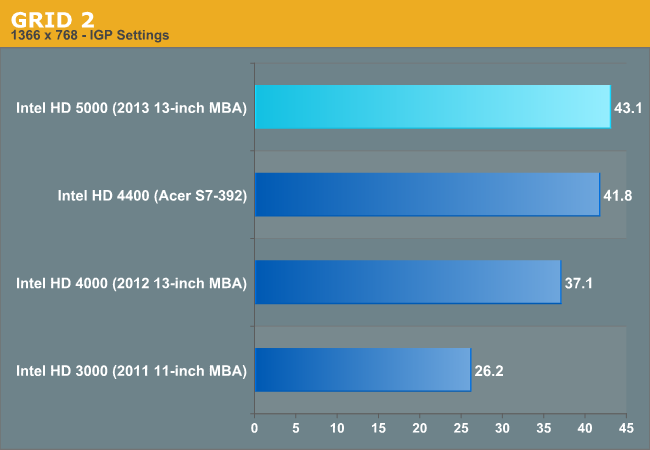
GRID 2 is absolutely playable on the new MacBook Air. At 43.1 fps it's 16% faster than last year's HD 4000 model. A 16% gain without increasing TDP on the same manufacturing process is pretty impressive. The gains over the 2011 MBA are substantial. GRID 2 goes from almost playable to fast enough where you can actually turn up some of the quality settings if you wanted to.
Next up is Borderlands 2. Again, a fairly modern title, but one that's really optimized for current generation consoles - making high-end processor graphics more than up for the task. While a higher TDP implementation of Haswell's integrated graphics wouldn't have an issue here, things are a little more difficult with a 15W TDP.
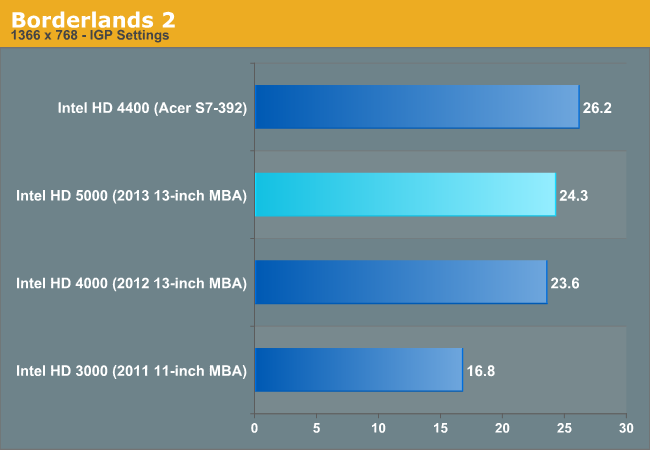
We see a marginal improvement over the HD 4000, we're clearly thermally bound at this point. What's interesting is the HD 4400 on the S7 is actually quicker here. The difference could be cooling or how Apple decides to scale back on GPU frequency when faced with thermal limits. A quick look at Haswell's power reporting confirms that while running my Borderlands 2 test the GPU was already exceeding the PL1 (Power Limit 1) of 15W:

Remember, with Sandy Bridge Intel introduced Turbo Boost 2.0 that effectively allowed for two separate power limits - one equal to the processor's TDP (PL1) and one higher than the processor's TDP (PL2) that could be hit as long as the die temperature doesn't get too high.
Despite the sub 30fps frame rate in this benchmark, Borderlands 2 was definitely playable on the HD 5000. It wasn't always smooth but if you need your single player fix, it'll suffice.
I've had a few requests to bring back our Minecraft benchmark. We ditched it from our higher end GPU reviews since it's no longer stressful enough, but for 15W TDP iGPUs it's perfect.
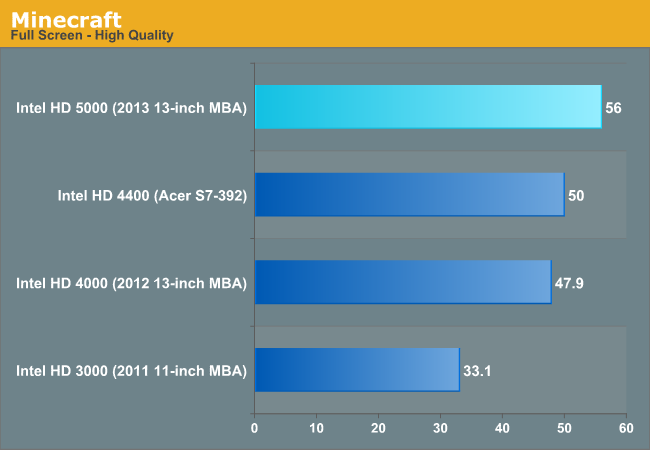
Once again we see almost a 17% increase over Intel's HD 4000. The HD 4400 comparison is also very impressive with a 12% increase in performance vs. what most MBA competitors will be using.
When I was a kid all I wanted was a console that could play arcade quality ports of Street Fighter II and Mortal Kombat II. These days, even the latest Street Fighter title has no issue playing on free graphics:
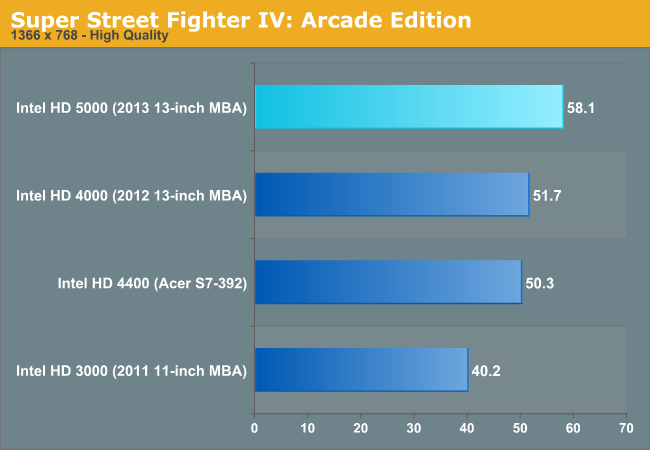
16% seems to be the magic number as that's exactly how much faster HD 5000 is compared to HD 4000. Given the lower TDP this year, that's a pretty reasonable gain. Looking at the sheer number of transistors that had to be used to get there however gives you good insight into just how hard it is to improve performance without a corresponding process node shrink.



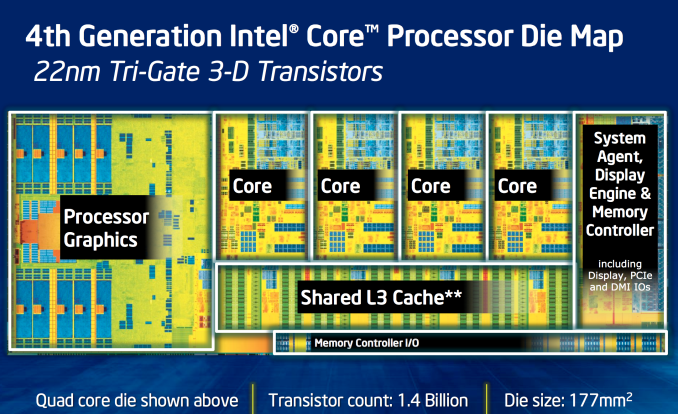
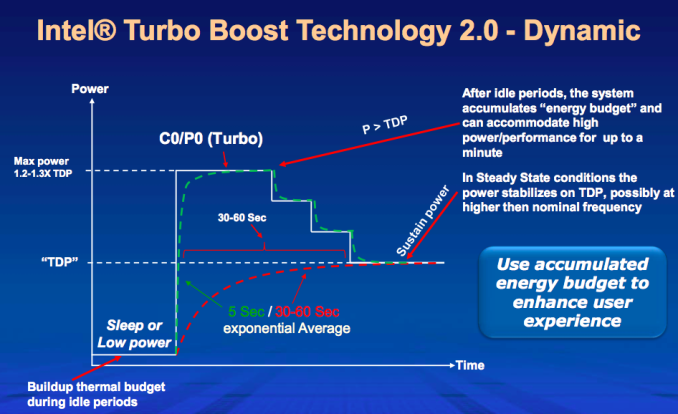








233 Comments
View All Comments
darwinosx - Monday, June 24, 2013 - link
Another peson who didn't read the article and knows nothing about Macs.watersb - Monday, June 24, 2013 - link
Excellent review!If only it were available with RAM...
darwinosx - Monday, June 24, 2013 - link
If only you took tow seconds to find out you can order it with 8 GB of ram.appliance5000 - Friday, December 20, 2013 - link
It's available with 8gb ram - but here's the rub: If you have the 512gb ssd coupled with the fact that it's mounted on the pcie bus, your page ins and outs are about as fast as memory - or seemingly so. It's a very fast machine - I've tested it stitching multi gb panos and editing multi gb layered files in CS6 and it just rips.FrozenDarkness - Monday, June 24, 2013 - link
I think people get retina confused with higher resolution computers. Couple things, your windows computer? DPI up scaling sucks too much to truly run retina. Know that retina on a 13 MBP actually runs at a resolution of 1280x800 to be truly "retina" or else you're just up-scaling then down-scaling and burning your graphics card in the process. So in a sense, it's not truly higher resolution in terms of workspace, just in terms of beauty to behold. This also means a MBA retina would have to be a different, higher resolution panel, than the one used in the 13" MBP and at that point, what is the point of the MBP? I think you're more likely to see the MBP become more lik the MBA in size than vice versa.Also, panel lottery sucks, let's not act like apple is the only manufacturer who has a panel lottery or that samsung are only in "review" units.
A5 - Monday, June 24, 2013 - link
Windows 8.1 is supposed to fix the DPI scaling in Windows. Win8 is already significantly better than 7.Beyond that, sharper pixels even without an increased workspace is still a good thing. I think the rMBPs have a mode that does both, anyway.
JarJarThomas - Tuesday, June 25, 2013 - link
Windows 8.1 can't fix the dpi scaling in windows cause the problem is that most desktop applications can't scale well.Fixing dpi scaling with win8 would be similar to the solution apple does for non retine enabled grafics, internally upscale it.
But that would not work with the way the windows grafic stack works and the applications are dependent on this.
So scaling will ONLY be better for modern ui apps, not for desktop apps.
And therefore it will suck
akdj - Wednesday, June 26, 2013 - link
'Desktop applications can't scale well' because and ONLY because of the underlying OS. It's up to the operating systems architecture to provide third party scaling options/abilities. As we've seen with the rMBP....in less than a year, literally hundreds of apps....from small developers ala Pixelmator to the monsters...AKA, Adobe....have updated their 'code' for HiDPI displays. As has Apple with their software....and Windows with their native apps. Look at the Surface Pro for instance. Anything other than native Windows programming is a PITA. Windows 8.1 absolutely can help...regardless of how the graphic stack is set up....it's that low level coding that Windows needs to get creative with. Especially with dozens of OEMs, screen sizes and ratios....it will absolutely fall into Windows hands to provide decent scaling options and APIs for developers. High Rez monitors aren't going anywhere. 4k was all the rage at CES this year....and $7,000 Sony 4k TVs are already at Best Buys.OSx meanwhile has done an excellent job with pixel doubling trickery for text....while allowing developers the ability to natively use every pixel available 'in app' when drawing, editing video or stills....et al.
That said, and as a rMBP and 11" Air owner, I can honestly say the Air's resolution doesn't bug me in the least. It's a 2011 core i7 and I use it daily....right along side my 15" rMBP...which is the best computer I've ever purchased. Almost a full year with it and it still brings a smile to my face. I started my computer life @ 14 with an Apple IIe in '85. I remember being jealous when my buddy got the 'color' screen for his IIc...while I continued to slave away on a green monochrome screen. Lol....I suppose its where we come from, our ages....and therefore, appreciation for higher resolution vs decent resolution (11" Air) more than adequate and a helluva lot better than other choices on the market. Dunno
Bkord123 - Tuesday, June 25, 2013 - link
I do not claim to know a ton about computers, and I'll be honest, half of this review looks like it's written in Latin to me. However, regarding the comment that Windows 8 is better than 7, didn't I read several headlines that Windows 8 is more or less responsible for a massive decline in PC sales?TheinsanegamerN - Sunday, June 30, 2013 - link
the main reason pc sales are declining is a mix of a poor economy and computers lasting longer. machines reached the point of being fast enough for consumers five or six years ago. most consumers dont run out to get the newest thing in laptops, they wait until their current one breaks, which is more pronounced when jobs are not certain and raises are nonexistent. they were declining before windows 8 made it to market, though windows 8 isnt helping at all.